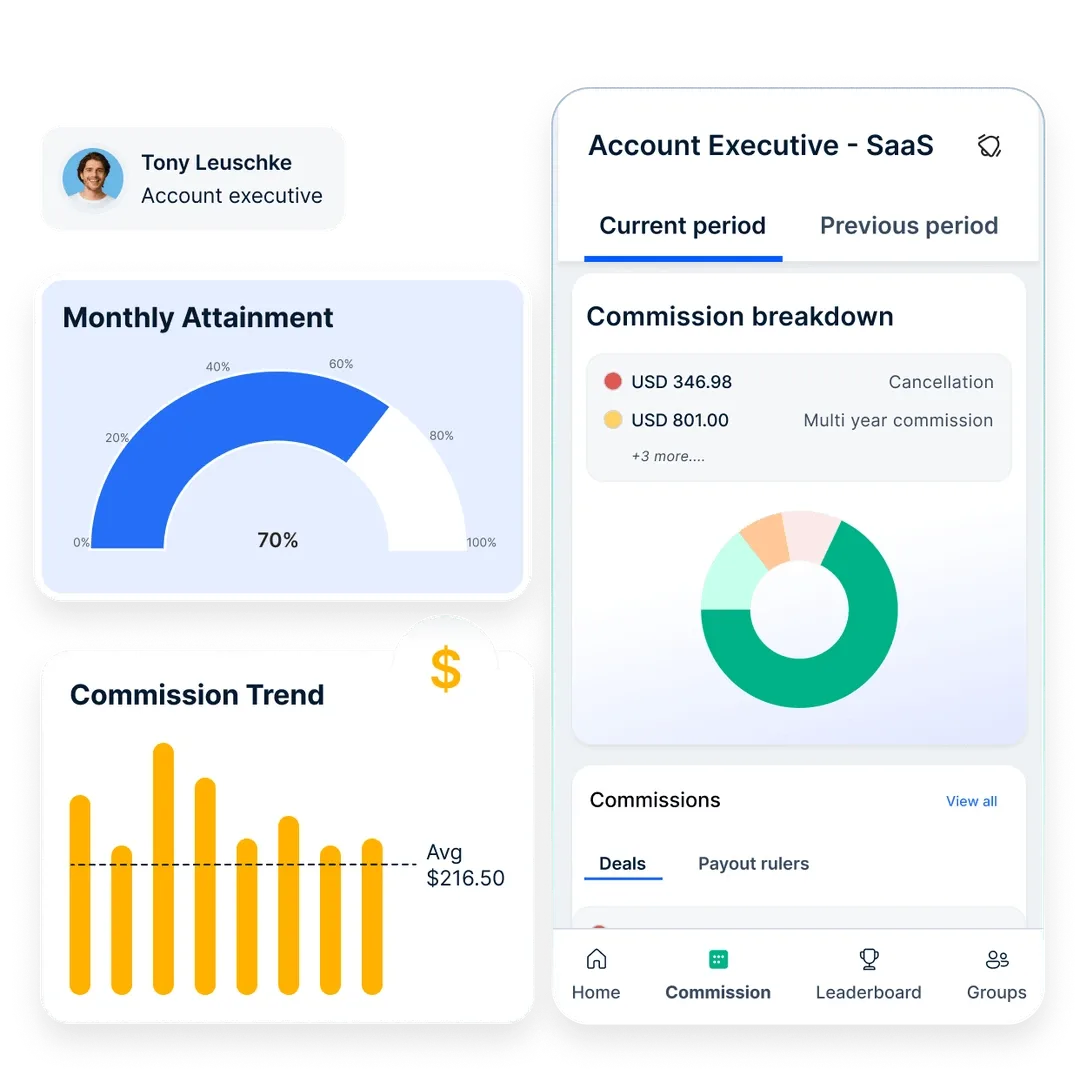13 indicateurs de performance commerciale à suivre pour réussir en 2025
Le suivi des bons indicateurs de performance commerciale est essentiel pour améliorer l'efficacité et conclure davantage d'affaires. Ce guide présente 13 indicateurs de productivité des commerciaux à suivre absolument, qui permettent de mesurer la réussite, d'optimiser les processus et d'obtenir de meilleurs résultats.
Sur cette page
Le suivi des indicateurs de performance des ventes est essentiel pour comprendre ce qui génère du chiffre d'affaires et les points à améliorer. En l'absence d'informations claires, les entreprises risquent de s'appuyer sur des suppositions plutôt que sur des décisions fondées sur des données.
Les équipes commerciales jonglent avec de multiples tâches, de la prospection à la conclusion d'affaires, mais tous les efforts ne mènent pas à des résultats. C'est pourquoi se concentrer sur les bons indicateurs de productivité des commerciaux permet d'identifier les goulets d'étranglement, d'optimiser les flux de travail et d'améliorer l'efficacité. Qu'il s'agisse de mesurer les taux de conversion des affaires, la durée du cycle de vente ou l'atteinte des quotas, ces indicateurs fournissent une image claire des performances.
Les indicateurs de performance des commerciaux ne se limitent pas au chiffre d'affaires, ils évaluent l'efficacité, l'engagement des clients et l'efficacité globale des ventes.
Ce guide explore les indicateurs clés de performance des ventes qui comptent le plus, aidant les entreprises à affiner leurs stratégies, à stimuler la productivité des ventes et à générer une croissance constante.
Qu'est-ce qu'un indicateur de performance commerciale ?
Les indicateurs de performance commerciale sont des indicateurs mesurables qui aident les entreprises à suivre et à évaluer l'efficacité de leurs efforts de vente. Ces indicateurs permettent de savoir dans quelle mesure les équipes de vente, les représentants individuels et les stratégies de vente globales contribuent à la génération de revenus.
Le suivi des bons indicateurs de productivité des commerciaux garantit que les équipes se concentrent sur les activités à fort impact, tandis que les indicateurs de performance des commerciaux permettent d'identifier les domaines à améliorer, d'optimiser les processus de vente et d'obtenir de meilleurs résultats.
Les mesures de performance commerciale comprennent généralement des indicateurs clés tels que les taux de conversion, la taille moyenne des affaires, la durée du cycle de vente, l'atteinte des quotas et le coût d'acquisition des clients. Ces données permettent aux entreprises d'affiner leurs stratégies, d'allouer efficacement leurs ressources et de s'assurer que les équipes de vente atteignent leurs objectifs.
13 indicateurs de performance commerciale à suivre impérativement
Pour vous aider à choisir les ICP de vente sur lesquels vous devez vous concentrer, nous avons élaboré un guide des indicateurs de performance de vente qui comptent, qui vous explique non seulement ce que sont ces ICP et leur utilité, mais qui vous montre également comment chacun d'entre eux peut être appliqué dans des situations commerciales quotidiennes.
1. Délai de réponse du chef de file
Le délai de réponse fait référence au temps que les commerciaux mettent à assurer le suivi des prospects. Les études sont sans équivoque quant à l'importance de cette mesure pour la qualification des prospects.
Selon HubSpot, il y a un 100x de qualifier un prospect si le vendeur prend contact avec lui dans les cinq minutes qui suivent la création du lead. Inside Sales indique que le taux de qualification des prospects augmente 21 fois lorsqu'un prospect est contacté dans les 5 minutes au lieu de 30 minutes.
Le mettre au travail :
Pour chaque vendeur, cet indicateur clé de performance est calculé en prenant le temps écoulé entre la création d'une piste et la première réponse pour chacune des pistes qui lui sont attribuées, puis en divisant ce total par le nombre total de pistes.
2. Productivité des ventes
La productivité des ventes, ou le temps consacré à la vente, est une mesure essentielle de la performance de l'équipe de vente. performance de l'équipe de vente. Les équipes très efficaces consacrent généralement une grande partie de leur temps à des activités à fort impact, telles que la prospection et les réunions avec les clients, et seulement une infime partie à des activités à faible impact, telles que les tâches administratives et le suivi de leurs commissions.
Une autre composante de la productivité commerciale est l'efficacité. Deux équipes de vente qui passent le même temps à vendre peuvent obtenir des résultats différents. Dans ce cas, l'équipe qui obtient les meilleurs résultats est considérée comme la plus efficace.
Le mettre au travail :
Cette mesure est le produit de l'efficience et de l'efficacité. Par exemple, le fait de contacter 20 prospects qualifiés au lieu d'utiliser ce temps pour des tâches comptables est un cas d'efficacité et d'efficience élevées.
En revanche, créer des modèles d'e-mails pour atteindre les prospects plutôt que d'envoyer un e-mail à chacun d'entre eux, c'est faire preuve d'une grande efficacité. Toutefois, la seconde méthode peut s'avérer plus efficace. Dans ce cas, l'efficacité de la première méthode l'emporte sur celle de la seconde.
3. Fuite de l'entonnoir de vente
Vous êtes-vous déjà demandé à quel endroit de votre entonnoir vos prospects abandonnent et à quel rythme ? C'est à cette question que répond cette mesure. Pour déterminer où votre processus de vente est le plus faible, il faut calculer le taux de conversion à chacune de ses étapes. L'identification de ces points faibles et la résolution des problèmes qui en découlent permettent d'obtenir de meilleurs résultats en matière de vente.
Le mettre au travail :
Supposons que 50 % des nouveaux prospects acceptent d'être appelés, que 40 % d'entre eux acceptent une démonstration et que 10 % d'entre eux deviennent des clients. Le taux élevé d'abandon à la dernière étape peut indiquer que les démonstrations sont inefficaces ou que les clients potentiels ne sont pas suffisamment qualifiés.
Les problèmes peuvent être variés, mais une fois que vous avez identifié ces problèmes potentiels, il devient plus facile de mettre le doigt sur le problème réel et de prendre des mesures.
4. Taux de réussite
Également connu sous le nom de taux de conversion, cet indicateur mesure le pourcentage de prospects qui se transforment en clients. Il permet également de déterminer le nombre de prospects dont vous avez besoin pour atteindre vos objectifs de chiffre d'affaires.
Au fil du temps, si le nombre d'affaires conclues reste le même alors que le taux de réussite augmente, cela indique que les performances de votre équipe de vente s'améliorent. En revanche, si votre équipe de vente conclut le même nombre d'affaires, voire moins, et que le taux de réussite diminue également, cela indique que quelque chose ne fonctionne pas dans votre processus de génération de leads ou dans d'autres processus de vente.
Le mettre au travail :
Supposons que vous puissiez identifier 600 pistes au cours d'un mois donné, dont 120 deviennent des clients, votre taux de réussite est alors de (600/120) = 20 %.
Si votre taux de réussite est de 20 %, votre objectif de chiffre d'affaires de 100 000 et la taille moyenne de vos contrats de 10 000, vous avez besoin de 10 contrats pour atteindre votre objectif de chiffre d'affaires, et (20/100) x = 10, où x est le nombre de pistes nécessaires. Ici, le nombre de pistes nécessaires, c'est-à-dire x, est de 50.
Le saviez-vous ? L'utilisation d'une approche ludique de la vente avec un produit doté de mécanismes de jeu intégrés peut stimuler la productivité des ventes et augmenter directement votre MRR ?
Indice: vous pourriez vouloir voir en quoi consiste la performance des objectifs de Compass .
5. Taille moyenne des transactions
Cette mesure vous indique dans quelle direction évolue la taille de vos contrats - à la hausse, à la baisse ou au même niveau. La taille moyenne des contrats peut être utile si vous essayez de monter en gamme (auquel cas vous souhaitez que l'indicateur augmente) ou de descendre en gamme (auquel cas vous essayez d'obtenir plus de clients PME et souhaitez que l'indicateur diminue) par rapport à votre situation actuelle.
Il est également utile de garder un œil sur les représentants pour lesquels cet indicateur est inférieur à la moyenne de l'équipe, car cela peut signifier qu'ils s'attaquent aux fruits les plus faciles à cueillir et qu'ils doivent peut-être cibler des clients plus importants. Il peut aussi s'agir d'une remise agressive.
Le mettre au travail :
La taille moyenne des transactions est calculée en divisant la valeur totale des transactions conclues par le nombre total de transactions. Par exemple, si l'entreprise a conclu deux affaires d'une valeur de 500 000 et 300 000 chacune, la taille moyenne de l'affaire est de 400 000. En d'autres termes, si vous avez un représentant commercial dont l'objectif de chiffre d'affaires est de 800 000 et que la taille moyenne des affaires est de 400 000, deux affaires doivent être conclues pour atteindre l'objectif.
6. Recettes
Passons maintenant à l'ICP le plus important : le chiffre d'affaires ou revenu brut. S'il s'agit d'un indicateur relativement simple, qui prend en compte les ventes brutes, les remises et la valeur des marchandises retournées, il ne s'agit pas d'un simple indicateur.
Le chiffre d'affaires peut être décomposé en trois éléments constitutifs : les nouvelles affaires, les ventes croisées/supplémentaires et les renouvellements. Vous souhaiteriez suivre le pourcentage du chiffre d'affaires que représente chacun de ces éléments pour savoir si vos efforts dans chacun de ces trois domaines portent leurs fruits.
Par exemple, si vous avez essayé d'améliorer la fidélisation des clients, vous devriez constater une amélioration du pourcentage d'affaires provenant des renouvellements.
Il est également important d'examiner les chiffres absolus de la contribution de chacun de ces éléments aux recettes. Il se peut qu'en pourcentage des recettes, la contribution d'un élément soit inférieure à ce qu'elle était auparavant. Pourtant, la valeur absolue des recettes qu'il génère a en fait augmenté.
Le mettre au travail :
Supposons que vous ayez 10 clients, chacun payant en moyenne 5 000 euros par mois. Votre chiffre d'affaires mensuel récurrent (MRR) - une mesure couramment utilisée par les entreprises d'abonnement - qui est essentiellement le chiffre d'affaires prévisible que vous recevez chaque mois, est de 50 000. Votre chiffre d'affaires annuel récurrent est de 50 000 x 12 = 600 000.
8. Valeur de la durée de vie du client (CLTV)
La valeur à vie du client (CLTV) est une mesure qui représente le revenu total qu'une entreprise peut attendre d'un seul compte client au cours de sa relation avec l'entreprise.
Le CLTV est important pour les entreprises car il permet de comprendre la valeur à long terme d'un client et d'orienter les décisions relatives aux stratégies d'acquisition et de fidélisation de la clientèle.
CLTV = Valeur d'achat moyenne × Fréquence d'achat × Durée de vie moyenne du client
Où :
- La valeur moyenne des achats est le montant moyen dépensé par un client par transaction.
- La fréquence des achats est le nombre moyen de transactions par client sur une certaine période.
- La durée de vie moyenne du client est la durée moyenne pendant laquelle un client continue d'acheter auprès de l'entreprise.
Le mettre au travail :
Si la valeur moyenne des achats est de 50 $, la fréquence des achats est de 2 fois par an et la durée de vie moyenne des clients est de 5 ans, alors.. :
CLTV = 50 $ × 2 × 5 = 500
Cela signifie qu'en moyenne, ce client devrait générer 500 dollars de revenus pour l'entreprise pendant toute la durée de la relation.
9. Taille moyenne des transactions
La taille moyenne d'une affaire est la valeur moyenne d'une affaire conclue par un représentant commercial. Elle donne une idée de la capacité du représentant commercial à négocier des affaires rentables et à faire de la vente incitative ou croisée de produits/services.
Taille moyenne de l'opération = Valeur totale des ventes / Nombre d'affaires conclues
Le mettre au travail :
Si un représentant commercial conclut 5 affaires d'une valeur totale de 10 000 dollars, la taille moyenne de l'affaire est de.. :
Taille moyenne de l'opération = 10 000 $ / 5 = 2 000
Cela signifie qu'en moyenne, chaque affaire conclue par le représentant commercial vaut 2 000 dollars.
10. Vitesse du pipeline de vente
La vélocité du pipeline de vente mesure la vitesse à laquelle les opportunités progressent dans le pipeline de vente. Elle permet de comprendre à quelle vitesse les affaires sont conclues et le chiffre d'affaires généré.
Vélocité du pipeline de vente = (Nombre d'affaires / Durée moyenne du cycle de vente) x Taux de réussite
Où :
- Le nombre d'affaires est le nombre total d'affaires dans le pipeline.
- La durée moyenne du cycle de vente est le temps moyen nécessaire pour conclure une affaire.
- Le taux de réussite est le pourcentage d'affaires gagnées.
Par exemple :
Si une équipe de vente a 50 affaires en cours, un cycle de vente moyen de 60 jours et un taux de réussite de 25 %, alors.. :
Vitesse du pipeline de vente = (50 / 60) x 0,25 = 0,21 affaire par jour
Cela signifie qu'en moyenne, l'équipe de vente conclut 0,21 affaire par jour.
11. Taux de fidélisation de la clientèle
Le taux de fidélisation des clients mesure le pourcentage de clients qu'une entreprise conserve au cours d'une période donnée. Il s'agit d'un indicateur important pour évaluer la fidélité des clients et l'efficacité des stratégies de fidélisation.
Taux de fidélisation de la clientèle = ((E - N) / S) x 100
Où :
- E est le nombre de clients à la fin de la période.
- N est le nombre de nouveaux clients acquis au cours de la période.
- S est le nombre de clients au début de la période.
Le mettre au travail :
Si une entreprise a 100 clients au début de l'année, acquiert 20 nouveaux clients et conserve 80 clients à la fin de l'année, alors.. :
Taux de fidélisation des clients = ((80 - 20) / 100) x 100 = 60 %.
Cela signifie que l'entreprise a conservé 60 % de ses clients au cours de l'année.
12. Délai de réponse du chef de file
Le délai de réponse aux prospects mesure le temps moyen nécessaire à un représentant commercial pour répondre à un nouveau prospect ou à une demande de renseignements. Un temps de réponse plus rapide est associé à des taux de conversion plus élevés et à une plus grande satisfaction des clients.
Le mettre au travail :
Si le délai de réponse moyen d'une équipe de vente est d'une heure, le délai de réponse sera d'une heure.
13. Mesures d'activité (appels, réunions, courriels) :
Les indicateurs d'activité permettent de suivre le nombre d'appels passés, de réunions planifiées et d'e-mails envoyés par un représentant commercial. Ces mesures permettent de comprendre le niveau d'activité et d'engagement avec les prospects et les clients.
Le mettre au travail :
Si un représentant commercial passe 20 appels, planifie 5 réunions et envoie 15 courriels au cours d'une semaine, les indicateurs d'activité pour cette semaine seront 20 appels, 5 réunions et 15 courriels.
Facteurs affectant les performances de vente
La fonction commerciale et ses performances sont cruciales pour toute entreprise. Il serait bon d'identifier, le plus tôt possible, les facteurs qui influencent positivement et négativement les performances de l'équipe de vente. Cela permettra à l'entreprise de se concentrer sur les domaines gagnants et de corriger le tir avant qu'il ne soit trop tard. Les facteurs qui affectent les performances de vente peuvent être divisés en deux grandes catégories : les facteurs internes et les facteurs externes.
1. Facteurs internes
Il s'agit de facteurs qui trouvent leur origine dans l'organisation et qui peuvent être contrôlés par elle. Le premier et le plus important de ces facteurs est la valeur du produit. Si les clients aiment et veulent le produit, l'équipe de vente sera plus performante que dans le cas contraire.
La stratégie de marketing mise en place par l'entreprise est un autre facteur essentiel qui influe sur le volume des ventes. La collaboration avec des agences de marketing à la performance peut aider à comprendre avec précision les principaux indicateurs de performance des ventes et à affiner les stratégies pour stimuler l'efficacité des ventes. Une stratégie marketing bien définie et bien ciblée est synonyme de meilleures performances commerciales.
D'autres facteurs internes influent sur les performances de vente, notamment la disponibilité d'un financement adéquat pour être compétitif sur le marché, l'accès aux derniers outils technologiques nécessaires à la vente et la capacité de l'entreprise à prospérer.
2. Les facteurs externes
Les facteurs externes qui affectent les performances de vente sont essentiellement fonction de l'environnement dans lequel l'entreprise opère. Bien que l'entreprise n'ait généralement pas de contrôle significatif sur ces facteurs, elle peut y répondre de manière stratégique.
Par exemple, la phase du cycle économique - c'est-à-dire la croissance, la récession, etc. - dans lequel se trouve le pays à ce moment-là peut influencer la demande de produits et donc le volume des ventes. Les forces concurrentielles sont un autre facteur qui influe sur les ventes. Plus la concurrence est forte, plus les performances de vente sont faibles. Les lois et réglementations affectent également les volumes de ventes sous la forme d'exigences de prix minimum, de taxes, etc.
Améliorez les performances de votre équipe de vente grâce à Compass

Le logiciel de gestion de la performance des ventes de Compass logiciel de gestion de la performance des ventes améliore le rendement des représentants commerciaux en fournissant une plateforme complète pour rationaliser et optimiser les divers aspects des opérations de vente. Voici comment Compass peut contribuer à améliorer le rendement des représentants commerciaux :
- Gestion de la rémunération incitative
Compass fournit des outils pour créer des programmes d'incitation efficaces qui s'alignent sur les objectifs de l'entreprise. En définissant clairement les incitations, les commerciaux sont motivés pour atteindre et dépasser leurs objectifs de vente, ce qui a un impact direct sur leurs performances et sur le chiffre d'affaires global de l'entreprise.
- Gestion des commissions de vente
Le logiciel automatise le calcul des commissions de vente, garantissant ainsi l'exactitude et le respect des délais. Cette automatisation réduit les erreurs et les litiges, ce qui permet aux commerciaux de se concentrer sur la vente plutôt que sur les tâches administratives. Elle améliore également la transparence dans le calcul des commissions, ce qui renforce la confiance et la satisfaction des représentants.
- Gamification des ventes
Compass intègre des éléments de gamification qui rendent le processus de vente plus attrayant pour les représentants. L'introduction de tableaux de classement, de badges et de récompenses favorise un environnement sain et compétitif qui encourage les représentants à être plus performants.
- Renseignements sur les recettes
La plateforme fournit des analyses et des informations sur les données de vente, aidant les commerciaux à comprendre les tendances du marché, le comportement des clients et les opportunités potentielles de vente incitative ou croisée. Ces informations permettent aux commerciaux de prendre des décisions fondées sur des données qui améliorent leurs stratégies de vente.
- Gestion des territoires et des quotas
Compass aide à définir et à gérer les territoires de vente et les quotas. Cela garantit que les efforts de vente sont stratégiquement alignés sur les opportunités du marché et que les représentants sont tenus responsables de la réalisation d'objectifs réalistes, étayés par des données.
- Intégrations et écosystème de partenaires
Grâce à ses capacités d'intégration étendues, Compass se connecte à d'autres outils d'entreprise tels que les systèmes de gestion de la relation client (CRM), ERPet les logiciels de ressources humaines. Cette connectivité permet aux commerciaux de disposer de toutes les informations nécessaires, améliorant ainsi leur efficacité.
Compass fournit un cadre solide qui motive les commerciaux par des incitations directes et les dote des outils et des connaissances nécessaires pour exceller dans leur rôle. Cela permet d'améliorer les performances et d'augmenter la productivité des ventes.
Comment Compass a aidé une plateforme automobile numérique à améliorer les performances de ses commerciaux grâce à des primes d'encouragement
L'un des principaux fournisseurs de solutions numériques pour l'automobile, le plus important d'Asie, met en relation les acheteurs de voitures avec les équipementiers, les concessionnaires et les vendeurs. Présente dans plus de 30 pays, l'entreprise propose un portefeuille varié de solutions automobiles et non automobiles.
Défi
Pendant 15 ans, les primes de vente ont été calculées manuellement et communiquées par courrier électronique, ce qui a été source d'inefficacité. Au fur et à mesure que l'entreprise se développait, la gestion des données relatives aux commissions en temps réel devenait de plus en plus complexe, ce qui réduisait la transparence pour les équipes de vente.
Solution
La société a mis en œuvre la solution de gestion des performances commerciales de Compass, qui automatise le calcul des commissions et fournit une visibilité en temps réel des objectifs par rapport aux réalisations.
Caractéristiques principales :
- Des tableaux de bord pour le suivi des performances et le classement.
- Des informations sur les régions et les désignations à l'intention des chefs d'entreprise.
Résultats
- Augmentation de 20 % de l'adoption du programme d'incitation dans les 100 jours.
- Augmentation de 18 % du nombre d'agents bénéficiant de mesures d'incitation.
- Augmentation de 25 % des primes d'intéressement, ce qui stimule les performances.
Vous voulez obtenir les mêmes résultats ? Essayez Compass dès aujourd'hui et rationalisez votre processus de commission sans effort.
Conclusion
Le suivi des bons indicateurs de performance commerciale permet d'évaluer chaque étape du processus de vente et de s'assurer que les équipes restent sur la bonne voie pour atteindre leurs objectifs. La compréhension des facteurs internes et externes affectant les ventes permet aux entreprises d'anticiper les défis et de capitaliser sur les opportunités, améliorant ainsi les mesures de productivité des commerciaux et les performances globales.
Chez Compass, nous avons conçu une solution puissante pour améliorer les efforts de vente et maintenir la motivation des équipes. Notre plateforme gamifiée, équipée de tableaux de bord, de cartes de score, de nudges et de notifications en temps réel, stimule l'engagement et la performance. Les entreprises qui utilisent Compass ont fait état d'une croissance significative des indicateurs de performance des ventes, allant d'un chiffre d'affaires plus élevé à une force de vente plus productive et plus motivée.













